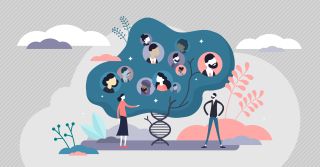Family Dynamics
Donor-Conceived People Who Have Always Known the Truth
Being donor-conceived can lead to inherent challenges, even if told early on.
Posted April 4, 2023 Reviewed by Kaja Perina
Key points
- Donor-conceived people are often very curious about their ancestry, family medical history, and close genetic relatives.
- They may struggle with the lack of information about their origins.
- They may have difficulty reaching out to new genetic relatives, including half-siblings and biological parents.
- They may need support as they explore and define their new donor family relationships.

The innate desire to know who and where we come from is a universal and fundamental aspect of human nature.
It stems from a deep-seated curiosity about our ancestry and heritage and is rooted in our basic need for a complete identity and a connection to others with whom we're closely related. This knowledge can provide us with a sense of continuity and connection to the past, and help us understand our place in the world.
Donor-conceived people (DCP) are created with one, or both, unknown or anonymous biological parents who sold their gametes (sperm or eggs). Unfortunately, this anonymity is almost always mandated for a minimum of 18 years, with many donor gametes still sold as anonymous forever. We know from the world of adoption that the innate human desire to know who we come from can be powerful, reflecting the deep-seated human need for understanding and defining one's identity.
In recent decades, many parents have come to understand the importance of telling their children the truth about their donor conception early on in life and understand that preverbal disclosure is best. DCP who have already had many years, or a lifetime, to incorporate their donor egg/sperm conception stories into their overall identities may be less likely to present for counseling treatment for this particular issue. These people may be neutral, accepting, and even embrace their donor origin story and may explore and incorporate their new donor family into their existing family with ease. At the same time, they may struggle with the knowledge that their close relatives, ancestry, and family medical information are being deliberately withheld from them, for a minimum of 18 years, and all too often, indefinitely. Even if a donor-conceived person is presenting for treatment for other reasons, it is relevant for counselors to understand their particular donor family situation as it may be referenced in the course of treatment.
Those whose conception stories have been shared with them since they were very young may feel or experience:
Curiosity about, and desire to establish relationships with their unknown biological parents (the donors) and their families, and also with half-siblings.1 They may feel frustrated with the lack of available information, specifically with the gamete vendor (the sperm bank or egg clinic) who will not release what is known about their close genetic relatives.2
Curiosity about medical history and about new and still unknown medical issues of close genetic family members. This is one of the most common reasons for seeking out first and second-degree donor relatives.3,4 For many people, the strong desire to know who they come from is driven by a need to understand their medical family history, including any potential health risks or predispositions they may have inherited. Knowing about one's family medical history is an important tool for promoting and protecting one's health, including important and specific pre-screenings and preventative health care. Knowing about our family health histories can help us better understand the complex interplay between genetics and environmental factors in the development of disease.
Ambivalent feelings about contacting the donor. The vast majority of offspring in all types of families desire contact with their unknown biological parent; however, comfort in expressing this curiosity may be lowest in dual-parent heterosexual families, with about one-quarter reporting an inability to discuss their origins with their social father,5 and in families who have used egg donation. It's common for DCP to be attuned to their non-bio parent’s discomfort with issues surrounding unknown genetic relatives and feel that conversations about them are not welcome or comfortable within the family. Too many DCP come to the Donor Sibling Registry (or submit their DNA to commercial testing sites) searching for answers behind their parents' backs, afraid that their curiosity will be hurtful to their parent(s) or damaging to these relationships.
A deep desire to know about their ancestry and countries of origin. This can allow individuals to explore and celebrate their cultural heritage and family history.
Struggling with a lack of male role models or support. For DCP with single mothers by choice or LGBTQ+ parents who have grown up knowing their conception story, growing up without a father or sufficient male role models might present in treatment. One large study reported that more than 37% of DCP with LGBTQ+ parents indicated that they had felt something missing from not being parented by a male figure.5
Challenged by the process of incorporating a large number of half-siblings into their lives,6,7 as discovering dozens of them is no longer uncommon. Many feel overwhelmed at the number of half-siblings they have already found and the ones yet to be discovered. It is not uncommon for a donor-conceived person to have more than 100 or even more than 200 half-siblings. The gamete-selling industry does not have accurate record keeping on the children born for any one donor (birth reporting is voluntary), therefore the "limits" they claim for each donor's offspring are not accurate. Many sperm banks have promised no more than 10 or 20 children for any one donor and some have constantly changing "limits" based on the largest half-sibling groups they see on the Donor Sibling Registry.
Grappling with unrealistic or idealized expectations for their donor and feeling subsequent disappointment when learning that the person is not as perfect as they've always imagined. Additionally, sometimes donors were not honest or accurate with the academic/physical attributes/medical history/career/etc. information that they entered on their donor profile, the non-identifying paperwork that parents receive when purchasing the gametes.
Difficulty with navigating relationships with parents and the siblings they’ve been raised with, as they connect with their new half-siblings and/or biological parent/donor. Parents may minimize the importance of connecting with donor relatives and may even feel threatened by, and against such contact and siblings' experiences and feelings may be different from their own. Some DCP have no desire to connect with their half-siblings or biological parents while many greatly desire contact.
A need for support for their feelings of ambiguous grief, loss, sadness, or a deep yearning to know about the unknown biological parent(s), siblings, and other close relatives.
Feelings and fear of rejection from attempted contact with the donor and/or half-siblings. It's important for DCP to understand that this is likely to be a product of the others’ own feelings and circumstances.
Fear around consanguinity and/or accidentally forming a romantic relationship with a half-brother or a half sister - a person who shares 50%of their DNA from the same donor. Because random meetings are not uncommon, this is a valid concern.
Challenges with re-defining family, setting boundaries, and navigating privacy/secrecy as they consider incorporating new relatives into their family circle. There can be difficulty opening to the idea that new genetic relatives are adding to a family, not taking away from it.
May parents believe that as long as they disclose the truth about donor sperm or egg origins to their kids early on, there won't be any difficulty with being a donor-conceived person. It is important to understand the scope of feelings and emotions that even those who have experienced early disclosure might feel. Parents and therapists can better serve DCP if they understand and embrace the struggles that might arise from being deliberately cut off from one's close relatives and from not knowing more about one's origins.
References
1. van den Akker, O. B., A., Crawshaw, M. A., Blyth, E. D., Frith. L., J. (2015). Expectations and experiences of gamete donors and donor-conceived adults searching for genetic relatives using DNA linking through a voluntary register. Human Reproduction, 30:111-21. doi: 10.1093/humrep/deu289.
2. Blyth, E., Crawshaw, M., Frith, L., & Jones, C. (2012). Donor-conceived people's views and experiences of their genetic origins: a critical analysis of the research evidence. Journal of Law and Medicine, 19, 769-89.
3. Canzi, E., Accordini, M. Facchin, F. (2019). 'Is blood thicker than water?' Donor conceived offspring's subjective experiences of the donor: a systematic narrative review. Reproductive Biomedicine Online, 38, 797-807. doi: 10.1016/j.rbmo.2018.11.033.
4. Macmillan, C. M., Allan, S., Johnstone, M., Stokes. M. A. (2021). The motivations of donor-conceived adults for seeking information about, and contact with, sperm donors. Reproductive Biomedicine Online, 43, 149-158. doi: 10.1016/j.rbmo.2021.04.005.
5. Beeson, D., Kramer, W. & Jennings, P. K. (2011). Offspring searching for their sperm donors: how family type shapes the process. Human Reproduction, 26, 2415–2424. https://doi.org/10.1093/humrep/der202
6. Scheib, J. E., McCormick, E., Benward, J. & Ruby, A. (2020). Finding people like me: contact among young adults who share an open-identity sperm donor. Human Reproduction Open. Published online 2020 Dec 23. doi: 10.1093/hropen/hoaa057
7. Indekeu, A., Bolt, S. H., Janneke, A. & Maas, B. M. (2021). Meeting multiple same-donor offspring: psychosocial challenges. Human Fertility (Cambridge), 12, 1-16. doi: 10.1080/14647273.2021.1872804.


